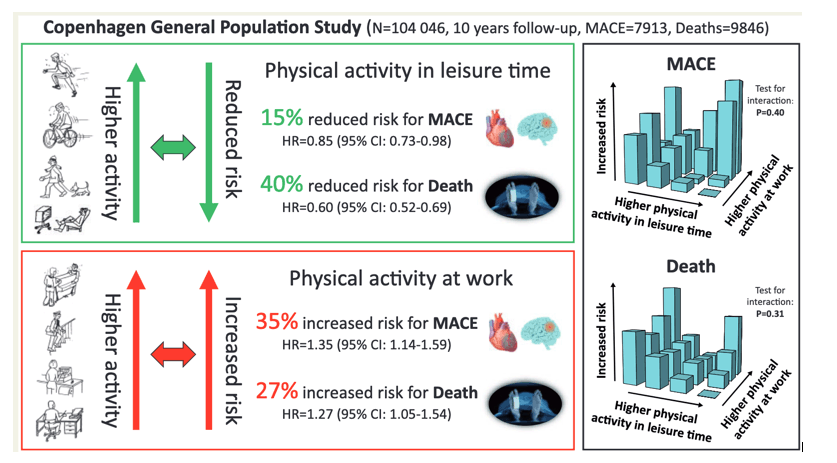| |
Exercise Reduced Heart Attacks & All-Cause Mortality
|
| |
| |
Download the PDF here
Higher leisure time physical activity associates with reduced major adverse cardiovascular events/MACE and all-cause mortality risk, while higher occupational physical activity associates with increased risks, independent of each other.
They confirmed their previous hypothesis that self-reported physical activity performed during leisure time is associated with reduced major adverse cardiovascular events (MACE) as well as all-cause mortality, whereas occupational physical activity is associated with an increased risk. This relationship has previously been termed the 'physical activity paradox'.2 , 3

Compared with low leisure time physical activity, data analysis revealed a significant risk reduction for MACE for leisure time physical activity when performed at moderate, high, or very high volume (intensity x duration) of 10, 18, and 9%, respectively.1
https://academic.oup.com/eurheartj/article/42/15/1512/6213773
Researchers found that participants had an increased risk for ischemic heart disease with every unit of increase in unhealthy lifestyle trajectory (HR = 1.08; 95% CI, 0.99-1.17). In addition, the association was highest among participants with comorbidities like hypertension (HR = 1.13; 95% CI, 1.03-1.24; P = .013), diabetes (HR = 1.23; 95% CI, 0.96-1.58; P = .097) or hyperlipidemia (HR = 1.09; 95% CI, 0.97-1.22; P = .166).
After a multivariable adjustment for lifestyle, health, living conditions and socioeconomic factors, compared with low volume of leisure-time physical activity, moderate, high or very high volume of leisure-time physical activity conferred reduced risk for major adverse CV events (HR for moderate = 0.86; 95% CI, 0.78-0.96; HR for high = 0.77; 95% CI, 0.69-0.86; HR for very high = 0.85; 95% CI, 0.73-0.98).
Higher levels of occupational physical activity were associated with elevated all-cause mortality risk compared with low levels (HR for high = 1.13; 95% CI, 1.01-1.27; HR for very high = 1.27; 95% CI, 1.05-1.54).
Compared with low leisure time physical activity, data analysis revealed a significant risk reduction for MACE for leisure time physical activity when performed at moderate, high, or very high volume (intensity x duration) of 10, 18, and 9%, respectively.1 In contrast, those groups reporting a high or very high volume of occupational physical activity revealed a significantly increased risk of MACE of 16% and 35%, respectively. Importantly, the two physical activity domains were revealed to be independent risk predictors. Higher levels of leisure time physical activity had a clear protective effect in those who had reported a sedentary job. Instead, leisure time activity had no benefit in those with high or very high levels of occupational activity, which underlines the independently increased health risk for blue collar workers, involved in heavy manual work.1
Manual jobs
"Many people with manual jobs believe they get fit and healthy by their physical activity at work and therefore can relax when they get home. Unfortunately, our results suggest that this is not the case," Holtermann said in a press release. "And while these workers could benefit from leisure physical activity, after walking 10,000 steps while cleaning or standing 7 hours in a production line, people tend to feel tired, so that's a barrier."
According to a related editorial, physical exercise performed during leisure or work time is different in character, as leisure time exercise comprises more aerobic endurance exercise, whereas occupational exercise primarily involves repetitive resistance exercise of short bouts and often insufficient recovery time.
"Moreover, workers in heavy manual jobs may be particularly exposed to psychological factors (eg, night shifts and environmental stressors such as noise or air pollution), which are less frequent in sedentary jobs (eg, office work). These stress factors may clearly affect the relationship between physical work as part of an occupation and cardiovascular risk factors," Martin Halle, MD, and Melanie Heitkamp, MD, with the department of prevention and sports medicine, University Hospital Klinikum rechts der Isar, Technical University in Munich, wrote.
|
|
| |
| |
|
|
|